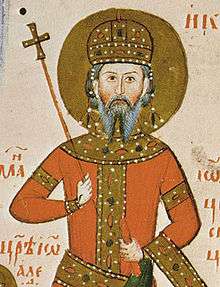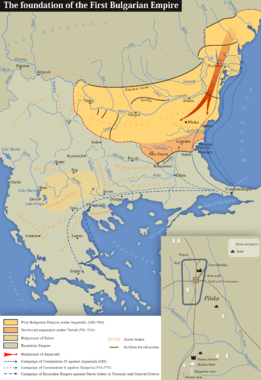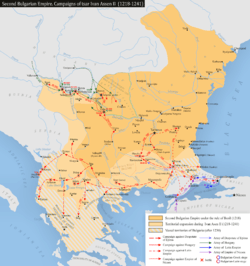Bulgarian Empire
| Bulgarian Empire | |||||
| ц︢рьство бл︢гарское | |||||
| |||||
.svg.png) Bulgaria during the reign of Simeon the Great, 10th century | |||||
| Capital | Pliska (681–893) Preslav (893–972) Skopje (972–992) Ohrid (992–1018) Tarnovo (1185–1393) Vidin (1371–1396/1422) | ||||
| Languages | Bulgar, Greek (681–893) Old Bulgarian (893–1018) Middle Bulgarian (1185–1396/1422) | ||||
| Religion | Bulgarian Orthodox (864–1018) Bulgarian Orthodox (1185–1204) Roman Catholic (1204–1235) Bulgarian Orthodox (1235–1396/1422) | ||||
| Government | Autocracy | ||||
| Monarch | |||||
| • | 681–700 | Asparukh (first) | |||
| • | 1397–1422 | Constantine II (last) | |||
| Historical era | Middle Ages | ||||
| • | Established | 681 | |||
| • | Disestablished | 1018 1185–1396/1422 | |||
| Today part of | |||||
In the medieval history of Europe, Bulgaria's status as the Bulgarian Empire (Bulgarian: Българско царство, Balgarsko tsarstvo [ˈbəlɡɐrskʊ ˈt͡sarstvʊ]), wherein it acted as a key regional power (particularly rivaling Byzantium in Southeastern Europe[1]) occurred in two distinct periods: between the seventh and eleventh centuries, and again between the twelfth and fourteenth centuries. The two "Bulgarian Empires" are not treated as separate entities, but rather as one state restored after a period of Byzantine rule over its territory.
First Bulgarian Empire

The First Bulgarian Empire was established on the territory both north and south of the lower course of the Danube River, and is usually described as having lasted between 681[2][3][4] and 1018, when it was subjugated by the Byzantine Empire despite Emperor Samuel's fierce resistance. It gradually reached its cultural and territorial apogee in the 9th century and early 10th century under Prince Boris I and Emperor Simeon the Great, when it developed into the cultural and literary center of Slavic Europe, as well as one of the largest states in Europe.
Second Bulgarian Empire


The medieval Bulgarian state was restored as the Second Bulgarian Empire after a successful uprising of two nobles from Tarnovo, Asen and Peter, in 1185, and existed until it was conquered during the Ottoman invasion of the Balkans in the late 14th century, with the date of its subjugation usually given as 1396, although some fringe views place it at 1422.[5] Under Ivan Asen II in the first half of the 13th century the country gradually recovered much of its former power, though this did not last long due to internal problems and foreign invasions. The Empire became tributary to the Golden Horde, a successor state of the Mongol Empire in the 13-14th century.[6][7] After the death of Emperor Ivan Alexander in 1371 Bulgaria was split into three countries and in the following decades fell under the domination of the Ottomans.
Maps
-

Bulgaria after its foundation by khan Asparukh in 681
-
-TsarSimeon-byTodorBozhinov.png)
Map of Bulgaria during its largest territorial extension under Simeon the Great
-

Map of Bulgaria during the reign of Samuel
-
.png)
Bulgaria under the brothers Peter and Asen
-

The Bulgarian Empire during the reign of Ivan Asen II
-

The Second Bulgarian Empire after the death of Ivan Alexander
See also
References
- ↑ War in the Balkans, 1991-2002 - R. Craig Nation - Google Books. Books.google.com. Retrieved 2012-06-28.
- ↑ A Concise History of Bulgaria, R. J. Crampton, Cambridge University Press, 2005, ISBN 0521616379, pp. 8-9.
- ↑ The New Cambridge Medieval History: Volume 1, c.500-c.700, Paul Fouracre, Cambridge University Press, 2005, ISBN 0521362911, p. 301.
- ↑ Мутафчиев, П. Гюзелев. В, История на българския народ 681-1323. Българска Академия на науките, 1986. стр. 106-108.
- ↑ http://liternet.bg/publish13/p_pavlov/konstantin_II_asen.htm
- ↑ Peter Jackson The Mongols and the West, p.204
- ↑ Denis Sinor, "The Mongols in the West", Journal of Asian History v.33 n.1 (1999).
Further reading
- Zlatarski, Vasil N. (2006) [1918]. Medieval History of the Bulgarian State (in Bulgarian). Sofia: Science and Arts Publishers, 2nd Edition (Petar Petrov, Ed.), Zahari Stoyanov Publishers, 4th Edition, 2006. ISBN 978-954-739-928-0.
- Бакалов, Георги; Милен Куманов (2003). Електронна издание – История на България (in Bulgarian). София: Труд, Сирма. ISBN 978-954-528-613-1.
- Делев, Петър; Валери Кацунов; Пламен Митев; Евгения Калинова; Искра Баева; Боян Добрев (2006). История и цивилизация за 11. клас (in Bulgarian). Труд, Сирма.
- Българите и България (in Bulgarian). Министерство на външните работи на България, Труд, Сирма. 2005.
- Fine, Jr., John V.A. (1991). The Early Medieval Balkans. Ann Arbor: University of Michigan Press. ISBN 978-0-472-08149-3.




